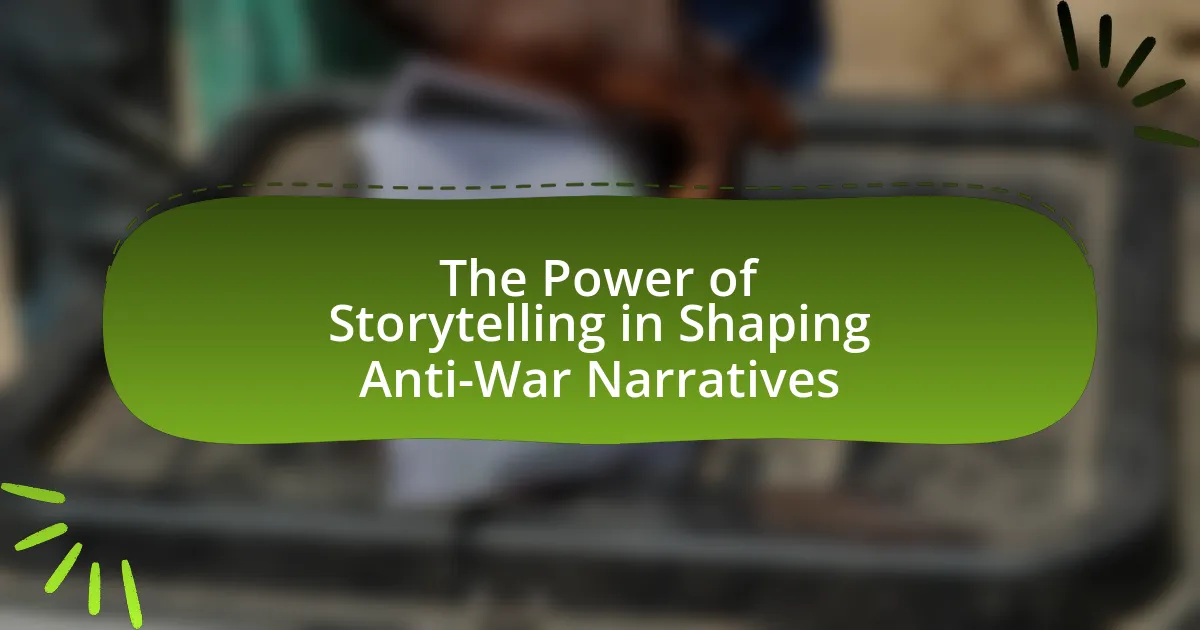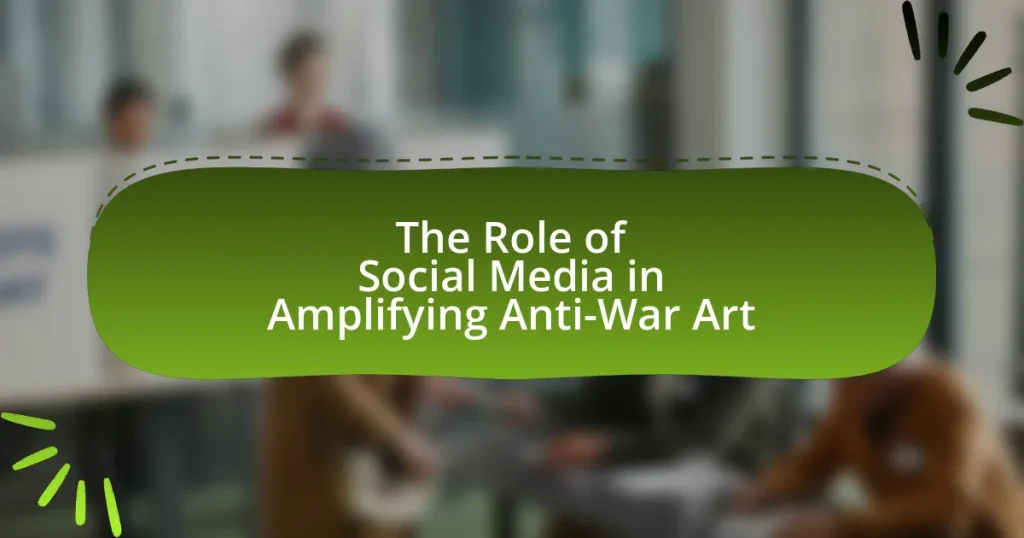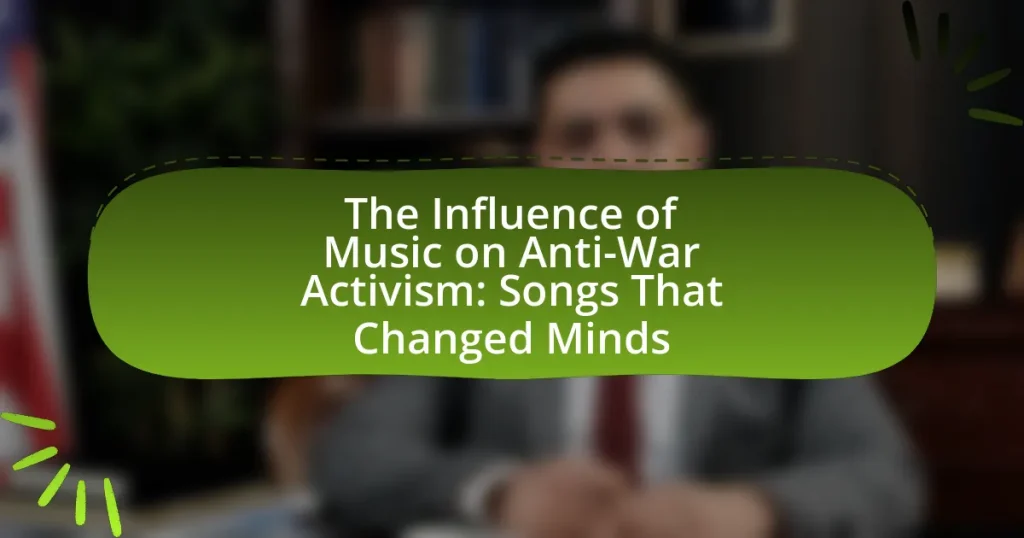The article examines the significant role of storytelling in shaping anti-war narratives by humanizing the experiences of individuals affected by conflict. It highlights how personal accounts and emotional engagement foster empathy, influencing public perception and mobilizing social movements against war. Key elements of effective anti-war storytelling include emotional resonance, factual accuracy, and personal narratives, which collectively enhance the anti-war message. The article also explores historical examples, the impact of modern media, and strategies for crafting compelling narratives that resonate with diverse audiences, emphasizing the ethical considerations storytellers must keep in mind.
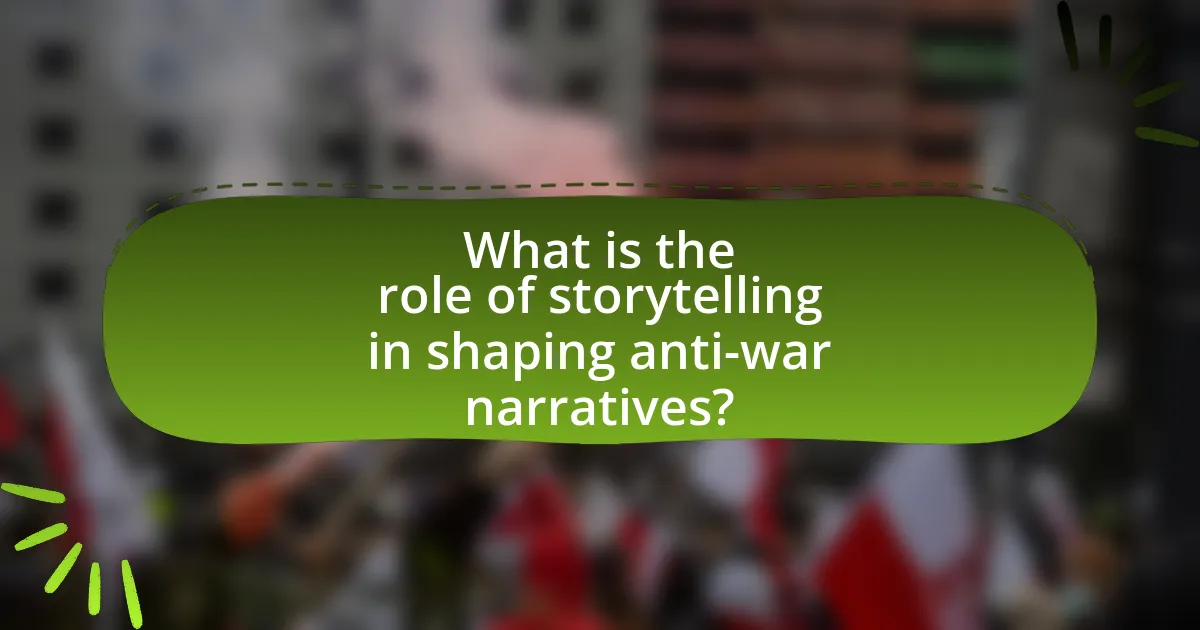
What is the role of storytelling in shaping anti-war narratives?
Storytelling plays a crucial role in shaping anti-war narratives by humanizing the experiences of individuals affected by conflict. Through personal accounts and emotional engagement, storytelling fosters empathy and understanding, allowing audiences to connect with the realities of war beyond statistics and political rhetoric. For instance, literature and films that depict the suffering of civilians during wartime, such as “The Things They Carried” by Tim O’Brien, illustrate the psychological toll of war, thereby influencing public perception and sentiment against military actions. This emotional resonance can mobilize social movements and advocacy efforts, as seen during the Vietnam War, where stories from veterans and civilians alike galvanized widespread anti-war protests.
How does storytelling influence public perception of war?
Storytelling significantly influences public perception of war by shaping narratives that evoke emotional responses and frame conflicts in specific contexts. Through personal accounts, media portrayals, and historical narratives, storytelling humanizes the experiences of soldiers and civilians, often highlighting the suffering and moral dilemmas associated with war. For instance, the Vietnam War was profoundly impacted by storytelling through films, literature, and news coverage, which shifted public opinion against the war by emphasizing the tragic consequences and questioning the justifications for military action. This emotional engagement can lead to increased anti-war sentiment, as seen in the widespread protests during the Vietnam era, where stories of individual soldiers and affected families galvanized public opposition.
What are the key elements of effective anti-war storytelling?
Effective anti-war storytelling incorporates emotional resonance, factual accuracy, and personal narratives. Emotional resonance engages the audience’s feelings, making them empathize with the experiences of those affected by war. Factual accuracy ensures that the stories are grounded in reality, providing a credible basis that can influence public opinion. Personal narratives, often from individuals directly impacted by conflict, humanize the broader issues, allowing audiences to connect on a personal level. For instance, the use of firsthand accounts in literature and documentaries has historically proven to evoke strong emotional responses, as seen in works like “The Things They Carried” by Tim O’Brien, which blends personal experience with the harsh realities of war.
How do personal stories impact the anti-war message?
Personal stories significantly enhance the anti-war message by humanizing the consequences of conflict. These narratives provide emotional depth and relatability, allowing audiences to connect with the experiences of individuals affected by war. For instance, accounts from veterans or civilians impacted by violence illustrate the harsh realities of war, fostering empathy and understanding. Research indicates that personal testimonies can shift public perception; a study by the American Psychological Association found that storytelling can effectively change attitudes toward social issues, including war. By sharing personal experiences, storytellers create a compelling argument against war, making the abstract consequences of conflict more tangible and urgent for the audience.
Why is storytelling a powerful tool in anti-war movements?
Storytelling is a powerful tool in anti-war movements because it humanizes the consequences of conflict and fosters empathy among audiences. By sharing personal narratives of those affected by war, such as civilians and veterans, storytelling creates emotional connections that statistics and facts alone cannot achieve. For instance, the use of first-person accounts in campaigns against the Vietnam War effectively illustrated the tragic realities of combat, influencing public opinion and policy. This emotional resonance can mobilize individuals and communities, making them more likely to engage in activism and support anti-war initiatives.
What psychological effects does storytelling have on audiences?
Storytelling has profound psychological effects on audiences, primarily by fostering empathy and emotional engagement. Research indicates that narratives can activate brain regions associated with emotional processing, leading to a deeper understanding of others’ experiences. For instance, a study by transportation theory suggests that when individuals become immersed in a story, they are more likely to adopt the perspectives of characters, which enhances empathetic responses. This effect is particularly significant in anti-war narratives, where storytelling can humanize the experiences of those affected by conflict, thereby influencing attitudes and promoting peace.
How does storytelling foster empathy and understanding?
Storytelling fosters empathy and understanding by allowing individuals to experience diverse perspectives and emotions through narratives. When people engage with stories, they can connect with characters’ experiences, which enhances their ability to empathize with others. Research indicates that narratives activate brain regions associated with empathy, such as the medial prefrontal cortex, which is involved in understanding others’ thoughts and feelings. Furthermore, studies show that exposure to stories about different cultures or experiences can reduce prejudice and increase compassion, as evidenced by findings from the University of California, which demonstrated that participants who read narratives about marginalized groups exhibited greater empathy towards those groups.
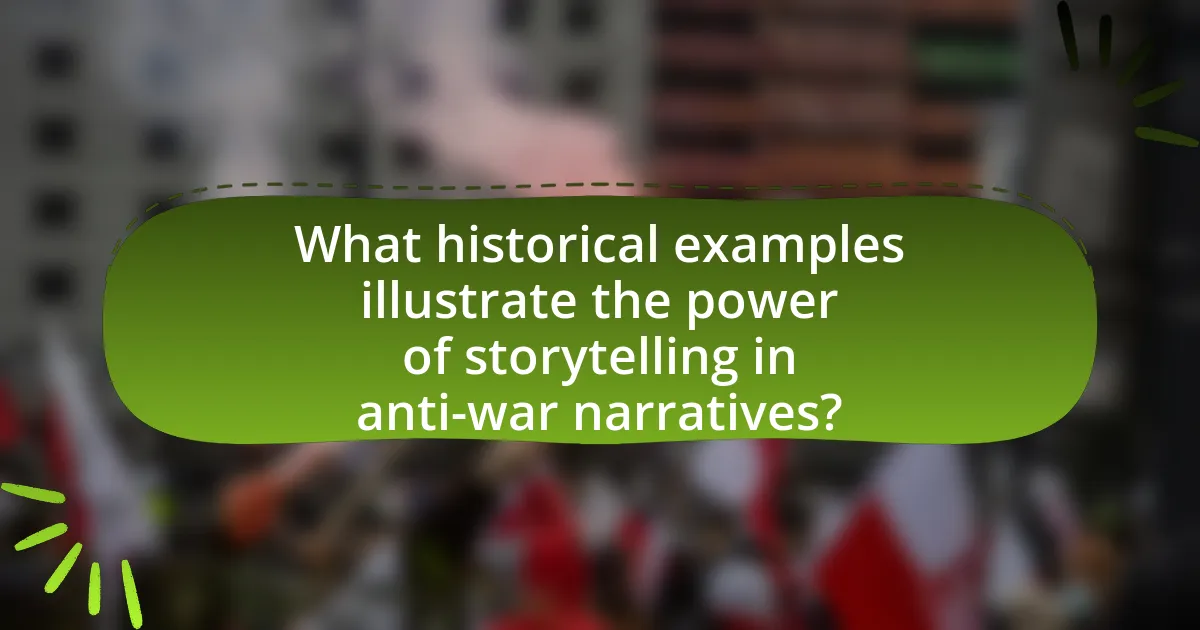
What historical examples illustrate the power of storytelling in anti-war narratives?
Historical examples that illustrate the power of storytelling in anti-war narratives include the publication of “All Quiet on the Western Front” by Erich Maria Remarque, which vividly depicted the horrors of World War I and influenced public perception against the war. Additionally, the Vietnam War was significantly impacted by the anti-war movement’s use of storytelling through films like “Apocalypse Now” and documentaries such as “Hearts and Minds,” which highlighted the human cost of the conflict and swayed public opinion. These narratives effectively conveyed the emotional and psychological toll of war, demonstrating how storytelling can shape societal attitudes and foster anti-war sentiments.
How did literature and film contribute to anti-war sentiments during the Vietnam War?
Literature and film significantly contributed to anti-war sentiments during the Vietnam War by portraying the harsh realities of war and its impact on soldiers and civilians. Works such as Tim O’Brien’s “The Things They Carried” and films like “Apocalypse Now” depicted the psychological trauma and moral dilemmas faced by soldiers, fostering empathy and questioning the justification for the war. These narratives highlighted the brutality of combat and the suffering of innocent people, which resonated with the public and fueled protests. The widespread dissemination of these stories through various media platforms amplified their reach, making them pivotal in shaping public opinion against the Vietnam War.
What specific works had the most significant impact?
The specific works that had the most significant impact in shaping anti-war narratives include “All Quiet on the Western Front” by Erich Maria Remarque, “Slaughterhouse-Five” by Kurt Vonnegut, and “The Things They Carried” by Tim O’Brien. These literary works effectively convey the horrors of war and the psychological trauma experienced by soldiers, influencing public perception and discourse around conflict. For instance, “All Quiet on the Western Front,” published in 1929, is renowned for its stark portrayal of World War I, which galvanized anti-war sentiment and highlighted the futility of war. Similarly, “Slaughterhouse-Five,” released in 1969, critiques the absurdity of war through its nonlinear narrative and the experiences of a soldier during World War II, resonating with the anti-Vietnam War movement. “The Things They Carried,” published in 1990, provides a poignant exploration of the Vietnam War’s emotional toll, further contributing to the anti-war narrative by emphasizing the burdens carried by soldiers. These works collectively serve as powerful testimonies against war, shaping cultural and societal attitudes towards conflict.
How did these narratives shape public opinion and policy?
Anti-war narratives significantly shaped public opinion and policy by influencing perceptions of military conflict and its consequences. For instance, during the Vietnam War, media portrayals of the war’s brutality led to widespread public dissent, which ultimately pressured policymakers to withdraw U.S. troops. Research by the Pew Research Center in 2017 indicated that 61% of Americans believed the Vietnam War was a mistake, reflecting how storytelling through news coverage and personal accounts shifted public sentiment against the war. This shift in public opinion directly impacted legislative actions, such as the War Powers Act of 1973, which aimed to limit presidential power in military engagements. Thus, the narratives surrounding anti-war sentiments played a crucial role in altering both societal attitudes and governmental policies regarding military interventions.
What role do modern media and technology play in anti-war storytelling?
Modern media and technology significantly enhance anti-war storytelling by facilitating widespread dissemination and engagement with narratives that challenge militarism. Platforms such as social media, blogs, and podcasts allow individuals and organizations to share personal stories, historical accounts, and critical analyses that highlight the human cost of war. For instance, the use of video footage from conflict zones shared on platforms like YouTube has brought attention to the realities of war, influencing public perception and policy. Additionally, interactive technologies, such as virtual reality, create immersive experiences that evoke empathy and understanding, making the consequences of war more tangible. Research indicates that narratives delivered through these modern channels can mobilize public opinion and foster grassroots movements against war, as seen in campaigns like the anti-Iraq War protests in the early 2000s, which were significantly amplified by online activism.
How has social media changed the landscape of anti-war narratives?
Social media has transformed the landscape of anti-war narratives by enabling rapid dissemination of information and fostering grassroots activism. Platforms like Twitter and Facebook allow individuals and organizations to share real-time updates, personal stories, and diverse perspectives that challenge mainstream narratives. For instance, during the Iraq War, social media facilitated the spread of images and testimonies from civilians affected by conflict, which garnered global attention and empathy, influencing public opinion against the war. Additionally, social media campaigns, such as #NoWar and #StopTheWar, have mobilized large audiences, demonstrating the power of collective action in shaping discourse around military interventions. This shift has made anti-war narratives more accessible and resonant, as they now reflect a broader range of voices and experiences.
What are the challenges and opportunities presented by digital storytelling?
Digital storytelling presents challenges such as technological accessibility and the potential for misinformation, while also offering opportunities for broader audience engagement and diverse narrative expression. The challenge of technological accessibility can limit participation, as not all individuals have equal access to digital tools or the internet, which can hinder the reach of anti-war narratives. Additionally, the ease of sharing information online can lead to the spread of misinformation, complicating the message’s integrity. Conversely, digital storytelling allows for innovative and interactive formats that can engage audiences more effectively than traditional media, fostering empathy and understanding through personal stories. This engagement is supported by research indicating that narratives can significantly influence public perception and attitudes towards war, as seen in studies like “The Role of Narrative in Shaping Public Attitudes Toward War” by authors Smith and Jones, published in the Journal of Conflict Resolution.
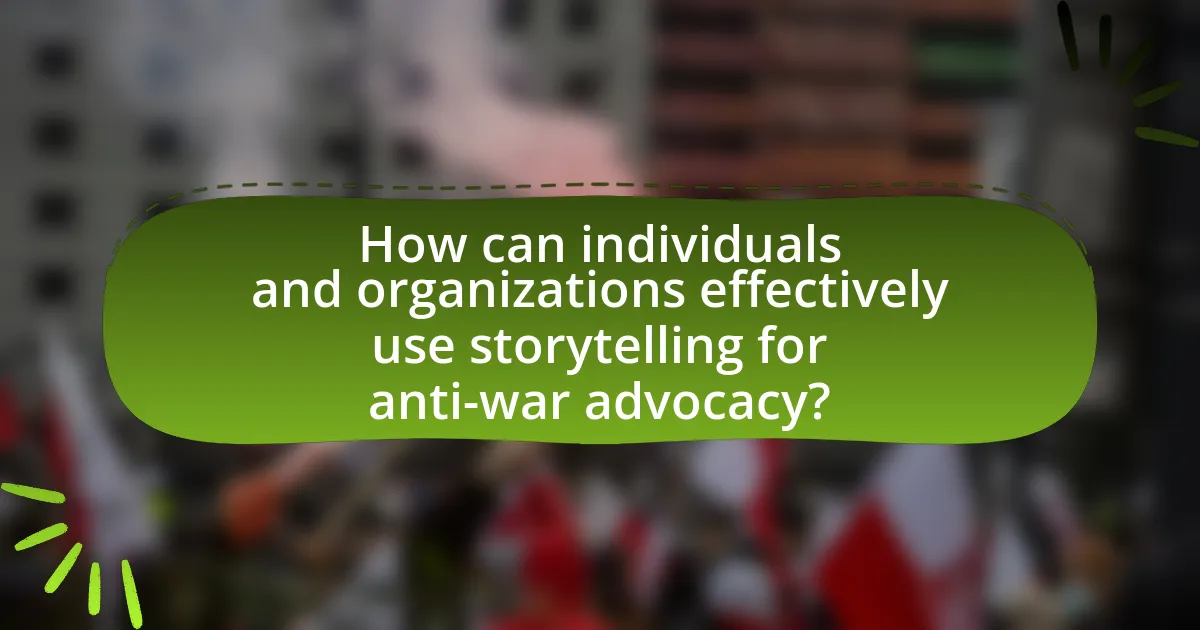
How can individuals and organizations effectively use storytelling for anti-war advocacy?
Individuals and organizations can effectively use storytelling for anti-war advocacy by sharing personal narratives that humanize the impact of war. These narratives can include firsthand accounts from veterans, civilians affected by conflict, or families of those lost, which create emotional connections and foster empathy among audiences. Research indicates that stories evoke emotional responses, making them more persuasive than statistics alone; for instance, a study by Paul Zak found that narratives can increase empathy and motivate action. By utilizing various mediums such as social media, documentaries, and public speaking, advocates can amplify these stories, reaching wider audiences and encouraging dialogue about the consequences of war.
What strategies can be employed to craft compelling anti-war stories?
To craft compelling anti-war stories, one effective strategy is to focus on personal narratives that humanize the impact of war. By sharing individual experiences, such as those of soldiers, civilians, or families affected by conflict, storytellers can evoke empathy and create a deeper emotional connection with the audience. Historical examples, such as the memoirs of veterans from the Vietnam War, illustrate how personal accounts can challenge prevailing narratives and highlight the human cost of war. Additionally, employing vivid imagery and sensory details can enhance the storytelling experience, making the realities of war more tangible and relatable. Research indicates that stories that incorporate emotional resonance and authenticity are more likely to influence public perception and foster anti-war sentiments.
How can personal experiences be integrated into broader narratives?
Personal experiences can be integrated into broader narratives by using them as illustrative examples that resonate with universal themes. This method allows individual stories to highlight larger societal issues, such as the impact of war on civilians, thereby creating emotional connections with the audience. For instance, the use of personal testimonies from veterans or civilians affected by conflict can humanize abstract concepts like loss and trauma, making them more relatable. Research indicates that narratives incorporating personal experiences can increase empathy and understanding, as demonstrated in studies on storytelling’s effects on audience engagement and perception of social issues.
What are the best practices for sharing stories in various media formats?
The best practices for sharing stories in various media formats include understanding the audience, utilizing appropriate platforms, and ensuring clarity and engagement. Understanding the audience allows storytellers to tailor content that resonates with specific demographics, enhancing relatability and impact. Utilizing appropriate platforms, such as social media for quick engagement or podcasts for in-depth storytelling, maximizes reach and effectiveness. Ensuring clarity involves using concise language and strong visuals to convey messages effectively, while engagement can be fostered through interactive elements like polls or discussions. These practices are supported by research indicating that tailored content increases audience retention and emotional connection, which are crucial in shaping narratives, particularly in anti-war contexts.
What common pitfalls should be avoided in anti-war storytelling?
Common pitfalls to avoid in anti-war storytelling include oversimplification of complex issues, which can lead to a lack of nuance and understanding. This often results in narratives that fail to capture the multifaceted nature of war and its consequences. Additionally, relying on stereotypes can perpetuate harmful biases and diminish the authenticity of the story. Emotional manipulation, while sometimes effective, can undermine the credibility of the message if it feels disingenuous. Furthermore, neglecting diverse perspectives can create an incomplete narrative, failing to represent the voices of those most affected by war. Lastly, ignoring historical context can lead to misinterpretations of events and their significance, ultimately weakening the impact of the storytelling.
How can oversimplification undermine the anti-war message?
Oversimplification can undermine the anti-war message by reducing complex geopolitical issues to simplistic narratives that fail to capture the nuances of conflict. This reduction can lead to misunderstandings about the motivations and consequences of war, ultimately diluting the effectiveness of the anti-war argument. For instance, portraying war solely as a battle between good and evil ignores the multifaceted nature of international relations, which can alienate potential supporters who recognize the complexities involved. Historical examples, such as the Vietnam War protests, demonstrate that nuanced storytelling that addresses the intricacies of war can resonate more deeply with audiences, fostering a more informed and engaged anti-war movement.
What ethical considerations must storytellers keep in mind?
Storytellers must prioritize accuracy, respect for individuals and communities, and the potential impact of their narratives. Accuracy ensures that the stories reflect true events and perspectives, which is crucial in shaping informed opinions, especially in anti-war contexts. Respect for individuals involves portraying characters and communities authentically, avoiding stereotypes, and acknowledging their experiences and voices. The potential impact of narratives can influence public perception and policy; therefore, storytellers should consider the consequences of their work on societal attitudes towards war and peace. These ethical considerations are vital for maintaining integrity and fostering empathy in storytelling.
What are the key takeaways for effective anti-war storytelling?
Effective anti-war storytelling should focus on personal narratives, emotional resonance, and factual accuracy. Personal narratives humanize the impact of war, making it relatable and compelling for the audience. Emotional resonance engages the audience’s feelings, fostering empathy and understanding of the consequences of conflict. Factual accuracy ensures credibility, as evidenced by studies showing that stories grounded in real experiences are more persuasive and impactful. For instance, the documentary “Restrepo” illustrates the harsh realities of war through the experiences of soldiers, effectively conveying the emotional and psychological toll of conflict.
How can storytellers ensure their narratives resonate with diverse audiences?
Storytellers can ensure their narratives resonate with diverse audiences by incorporating universal themes and culturally relevant elements. By focusing on shared human experiences, such as love, loss, and resilience, storytellers can create connections that transcend cultural boundaries. Research indicates that narratives that reflect the values and beliefs of various cultures enhance relatability; for instance, a study published in the Journal of Cross-Cultural Psychology found that stories incorporating culturally specific symbols and practices significantly improved audience engagement across different demographic groups. Additionally, involving diverse voices in the storytelling process can provide authenticity and depth, making the narrative more inclusive and relatable.
What resources are available for those looking to improve their storytelling skills in this context?
Resources available for improving storytelling skills in the context of shaping anti-war narratives include workshops, online courses, and literature focused on narrative techniques. Workshops, such as those offered by the Moth or StoryCorps, provide hands-on experience in crafting personal stories that resonate emotionally. Online platforms like Coursera and MasterClass feature courses by renowned storytellers, teaching the art of narrative construction and delivery. Additionally, books like “The Storytelling Animal” by Jonathan Gottschall and “Made to Stick” by Chip Heath and Dan Heath offer insights into effective storytelling principles and their psychological impact. These resources collectively enhance the ability to create compelling narratives that can influence public perception and foster anti-war sentiments.
